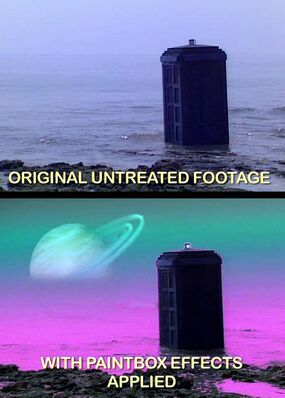Quantel Paintbox: Difference between revisions
(Undo revision 1474071 by StevieGLiverpool (talk)) |
(The Quantel Paintbox wasn't used for The Leisure Hive, because it didn't exist at the time.) |
||
| Line 5: | Line 5: | ||
Though mainly used to superimpose things like [[wikipedia:lower third|lower third]]s and other textual elements, it could be used to superimpose anything on any part of the picture. Paintbox also allowed for an early form of [[colourist|colour grading]]. Though many of the [[serial]]s in the [[Sixth Doctor|Sixth]] and [[Seventh Doctor]]s' eras used Paintbox to varying degrees, one of the stories to make obvious use of the technology was ''[[Mindwarp]]''. [[The Making of The Trial of a Time Lord: Part Two - Mindwarp|Its "making of" documentary]] demonstrated the effects that Paintbox could accomplish in the mid-1980s. | Though mainly used to superimpose things like [[wikipedia:lower third|lower third]]s and other textual elements, it could be used to superimpose anything on any part of the picture. Paintbox also allowed for an early form of [[colourist|colour grading]]. Though many of the [[serial]]s in the [[Sixth Doctor|Sixth]] and [[Seventh Doctor]]s' eras used Paintbox to varying degrees, one of the stories to make obvious use of the technology was ''[[Mindwarp]]''. [[The Making of The Trial of a Time Lord: Part Two - Mindwarp|Its "making of" documentary]] demonstrated the effects that Paintbox could accomplish in the mid-1980s. | ||
It is sometimes stated that the Paintbox was first used on ''Doctor Who'' for ''[[The Leisure Hive]]'', but this is not the case, as that serial was produced in 1980 and the Paintbox was not launched until 1981, and in any event it was unable to manipulate moving video. The digital video effects for ''[[The Leisure Hive]]'' were actually created by the Quantel DPE 5000, one of the earliest real-time digital video effects processors, also sometimes unofficially known as the "Quantel Image Processor" or simply "the Quantel". | |||
{{reflist}} | {{reflist}} | ||
{{wikipediainfo}} | {{wikipediainfo}} | ||
{{terminology stub}} | {{terminology stub}} | ||
[[Category:Terminology]] | [[Category:Terminology]] | ||
Revision as of 10:31, 26 July 2013
The Quantel Paintbox, or simply Paintbox[1] was a graphics workstation which revolutionised the way television graphics were produced in the 1980s. Typically of greatest utility to sports and news programming, Paintbox was occasionally repurposed by the British Broadcasting Corporation and used for dramatic and entertainment programming as well. Doctor Who was one of the system's earliest and most enthusiastic adopters in the BBC's Drama Series department.
Though mainly used to superimpose things like lower thirds and other textual elements, it could be used to superimpose anything on any part of the picture. Paintbox also allowed for an early form of colour grading. Though many of the serials in the Sixth and Seventh Doctors' eras used Paintbox to varying degrees, one of the stories to make obvious use of the technology was Mindwarp. Its "making of" documentary demonstrated the effects that Paintbox could accomplish in the mid-1980s.
It is sometimes stated that the Paintbox was first used on Doctor Who for The Leisure Hive, but this is not the case, as that serial was produced in 1980 and the Paintbox was not launched until 1981, and in any event it was unable to manipulate moving video. The digital video effects for The Leisure Hive were actually created by the Quantel DPE 5000, one of the earliest real-time digital video effects processors, also sometimes unofficially known as the "Quantel Image Processor" or simply "the Quantel".
- ↑ Often on DVD special features, interviewees or info text writers unfamiliar with special effects will also refer to this system as just Quantel or "the Quantel", This is not, however, a terribly accurate way of referring to it, as Quantel is the company name, and they made more than just Paintbox.

